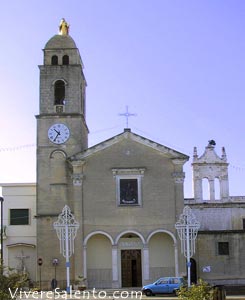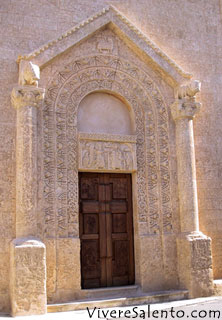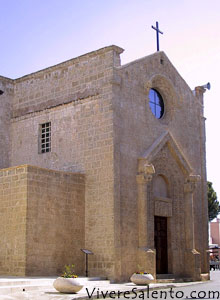|
|

The ducal Palace of Taurisano has taken the place of the old
Angevin fortress dating to the 13th century. It
 was
built according to the will of the De Taurisanos. Between 1733 and 1948 the old
building was demolished and rebuilt several times. The building includes also
the chapel of Our Lady of the Consolation with its 18th century painting
representing St Alessandro. In the historic centre there are several ‘case a
corte’ and other palaces of wealthy families: Casto Palace (18th century), Ponzi
Palace (19th century) Colona Palace (18th century), Potenza Palace (beginning of
the century) Romasi Palace (16th century), Lopez y Royo Palace (19th century)
and many others. The most important church is certainly the Parish Church
dedicated to the Transfiguration. It was built between 1796 and 1820 according
to the will of the Duke Antonio Lopez y Royo on a pre-existing structure dating
to the 16th century. The façade has a Neoclassical and Late Baroque Style. On
the portal there is the sculpture of a bull as on the civic coat of arms. The
church has a Latin Cross plan, inside there are was
built according to the will of the De Taurisanos. Between 1733 and 1948 the old
building was demolished and rebuilt several times. The building includes also
the chapel of Our Lady of the Consolation with its 18th century painting
representing St Alessandro. In the historic centre there are several ‘case a
corte’ and other palaces of wealthy families: Casto Palace (18th century), Ponzi
Palace (19th century) Colona Palace (18th century), Potenza Palace (beginning of
the century) Romasi Palace (16th century), Lopez y Royo Palace (19th century)
and many others. The most important church is certainly the Parish Church
dedicated to the Transfiguration. It was built between 1796 and 1820 according
to the will of the Duke Antonio Lopez y Royo on a pre-existing structure dating
to the 16th century. The façade has a Neoclassical and Late Baroque Style. On
the portal there is the sculpture of a bull as on the civic coat of arms. The
church has a Latin Cross plan, inside there are nine altars and beautiful paintings such as that representing the Virgin of the
Rosary and that of St Oronzo, a wooden statue of the Virgin dating to 17th
century, a wooden choir of 1830. The church of St Mary of the Road was built in
the 13th century. Its façade is richly decorated and the portal has two columns
with the statues of two animals , a bull and a lion. The bell tower dates to the
18th century with a Byzantine sundial of the 14th century. Inside there are
several altars , valuable 16th century frescos and a beautiful 17th century
organ. The church of St Stephen was built on the rests of an old medieval
building and was restored several times. The bell tower dates to 1891 and on the
portal there is a beautiful fresco of the saint. The chapel of the St Holy
Crucifix is more recent and was built in 1904 according to the will of Ippazio
Schiavano. The oak of Holy Crucifix is situated near the Chapel and it is as
large as to shade it. In the territory of Taurisano there are also several farms
and underground oil mills. The oil mill of Ortensano is probably the oldest one
and it dates to the 14th century. Other oil mills are that of the Ponzis, that
of the Lopezes y Royo, that of the Colonas and that of the Barons Romasi. The
Masseria De Pasquale is one of the several farms of Taurisano, it dates to the
15th century. The patron saints of the village are St Stephen celebrated on the
3rd August and the St Mary of the Road celebrated on 8th September.
nine altars and beautiful paintings such as that representing the Virgin of the
Rosary and that of St Oronzo, a wooden statue of the Virgin dating to 17th
century, a wooden choir of 1830. The church of St Mary of the Road was built in
the 13th century. Its façade is richly decorated and the portal has two columns
with the statues of two animals , a bull and a lion. The bell tower dates to the
18th century with a Byzantine sundial of the 14th century. Inside there are
several altars , valuable 16th century frescos and a beautiful 17th century
organ. The church of St Stephen was built on the rests of an old medieval
building and was restored several times. The bell tower dates to 1891 and on the
portal there is a beautiful fresco of the saint. The chapel of the St Holy
Crucifix is more recent and was built in 1904 according to the will of Ippazio
Schiavano. The oak of Holy Crucifix is situated near the Chapel and it is as
large as to shade it. In the territory of Taurisano there are also several farms
and underground oil mills. The oil mill of Ortensano is probably the oldest one
and it dates to the 14th century. Other oil mills are that of the Ponzis, that
of the Lopezes y Royo, that of the Colonas and that of the Barons Romasi. The
Masseria De Pasquale is one of the several farms of Taurisano, it dates to the
15th century. The patron saints of the village are St Stephen celebrated on the
3rd August and the St Mary of the Road celebrated on 8th September.

The people of Taurisano are usually called ‘mangia culummi’
(fig eater) and "caucinari", lime producer. They
 are
also called "critazzari" (people that shouts) or "curteddi"(knives). Those names
come from the history of the village because in the past they used to produce
and sell lime. They used to shout in order to have the attention of their
customers and to walk in the countryside to sell the lime. Probably they used to
stole and eat the figs from somebody else’s tree.In Taurisano there is a legend
about the Specchia Silva, a megalithic complex. In the 18th century, a woman had
a dream. She saw a huge treasure buried under the Silva. The morning after, as
soon as she woke up, she went there and began to dig. Suddenly a large hole
appeared open wide and she saw many gold coins, but when she moved to take them,
the hole closed mysteriously. The woman was so terrified that she run home and
had a fever for a whole month. are
also called "critazzari" (people that shouts) or "curteddi"(knives). Those names
come from the history of the village because in the past they used to produce
and sell lime. They used to shout in order to have the attention of their
customers and to walk in the countryside to sell the lime. Probably they used to
stole and eat the figs from somebody else’s tree.In Taurisano there is a legend
about the Specchia Silva, a megalithic complex. In the 18th century, a woman had
a dream. She saw a huge treasure buried under the Silva. The morning after, as
soon as she woke up, she went there and began to dig. Suddenly a large hole
appeared open wide and she saw many gold coins, but when she moved to take them,
the hole closed mysteriously. The woman was so terrified that she run home and
had a fever for a whole month.
|